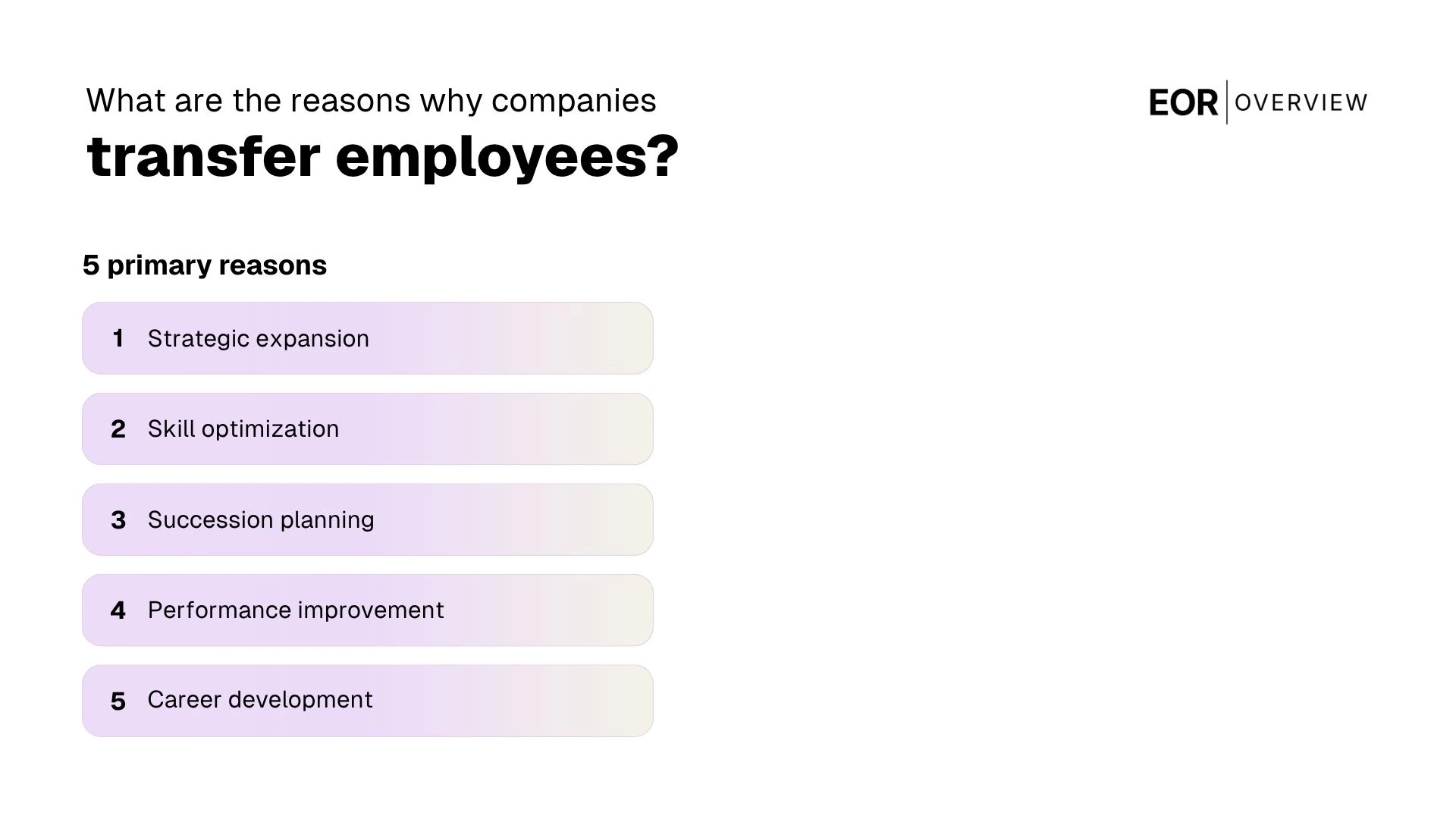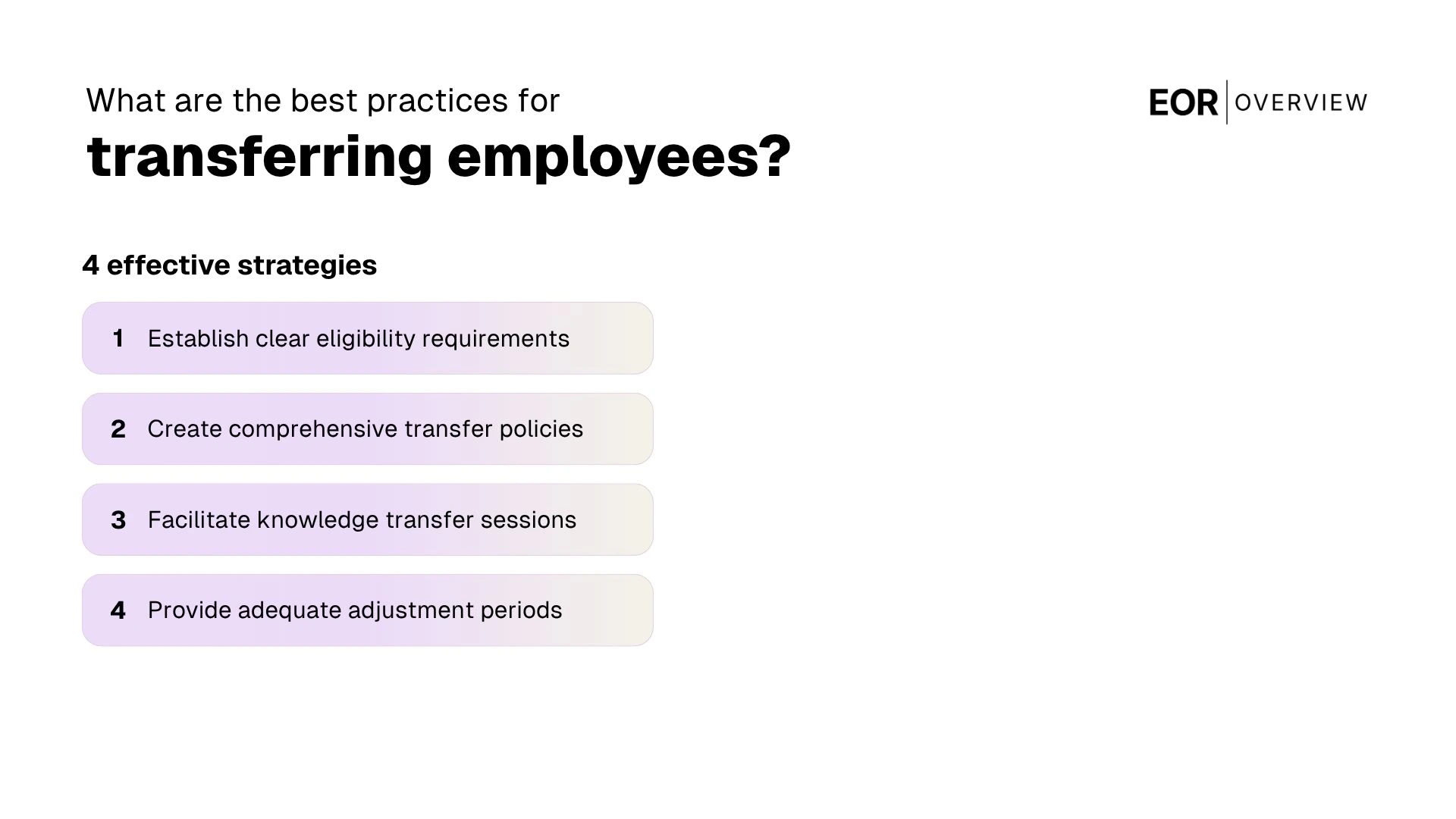Employee transfer is a strategic human resource process that involves moving an existing employee from one position, department, or location to another within the same organization while maintaining their employment relationship and often preserving their benefits and tenure.
In today's dynamic business environment, especially within tech companies and startups scaling rapidly across multiple locations, employee transfers have become a critical tool for retaining top talent, filling skill gaps, and supporting business expansion. Rather than losing valuable employees to external opportunities or struggling to find qualified candidates externally, smart organizations leverage internal mobility to maintain a competitive advantage while boosting employee satisfaction and career development.
Organizations with strong internal mobility programs are significantly more likely to retain high-performing employees and reduce recruitment costs, making employee transfers a cornerstone of modern talent management strategy.
What is employee transfer?
An employee transfer is a strategic workforce management process that involves moving an employee from one position, department, or location to another within the same organization. This transfer process enables companies to optimize talent allocation, address business needs, and provide career development opportunities while retaining valuable institutional knowledge.
The main categories include departmental transfers, location-based transfers, promotional transfers, lateral transfers, and temporary assignments. These transfer involves different levels of complexity and planning requirements.
Departmental transfer: Moving employees between different departments or business units to leverage their skills in new areas or fill critical gaps.
Geographic relocation: Transferring employees to different office locations, branches, or international subsidiaries to support expansion or operational needs.
Promotional transfer: Combining career advancement with a move to a new role or location, often involving increased responsibilities and compensation.
Lateral transfer: Moving employees to similar-level positions to provide new experiences, prevent burnout, or align skills with business priorities.
A well-defined transfer policy helps organizations ensure consistency, fairness, and legal compliance throughout the process. The type of transfer determines the specific procedures, timelines, and support mechanisms required to successfully transfer employees while maintaining productivity and employee satisfaction.
What are the common types of employee transfers?
Employee transfers fall into several distinct categories, each serving different organizational needs and career development goals. Understanding these transfer types helps hr professionals manage employee moves effectively while maintaining compliance and employee satisfaction.
The most common transfer types include location transfers, promotion transfers, replacement transfers, and lateral transfers. These employee moves are listed in detail below.
Location transfer: This transfer involves moving an employee to a different geographical location while maintaining the same role and responsibilities, often driven by business expansion or employee relocation requests.
Promotion transfer: Moving an employee from one department to another with increased responsibilities and compensation, combining career advancement with organizational restructuring needs.
Replacement transfer: Moving an employee from one position to fill a critical vacancy in another department, ensuring business continuity while providing the employee with a new role opportunity.
Lateral transfer: Shifting an employee to a similar-level position in a different department, often used for skill development or to address performance issues without demotion.

Reasons why companies transfer employees
Organizations typically initiate an employee transfer for strategic expansion, skill optimization, succession planning, performance improvement, and employee development. These reasons reflect both business needs and talent management objectives within the organization.
These reasons for transferring an employee are listed in detail below.
Strategic expansion: Companies often need experienced talent when opening new locations or departments. Relocating an employee with proven expertise ensures consistent operations and cultural alignment across different sites.
Skill optimization: A versatility transfer allows organizations to match employee strengths with specific departmental needs. This approach maximizes productivity by placing talent where their skills create the most value within the company.
Succession planning: Moving high-potential employees to different roles prepares them for leadership positions. This employee transfer involves exposing candidates to various business functions and building comprehensive organizational knowledge.
Performance improvement: Sometimes transferring an employee to a different environment or role can reignite their engagement and productivity. A fresh start within the same organization often resolves performance challenges.
Career development: Strategic transfers help employees develop new skills and advance their careers. This approach demonstrates the company's investment in talent growth while retaining valuable team members.
Most successful transfers include comprehensive relocation assistance to ensure smooth transitions and maintain employee satisfaction throughout the process.

What are the best practices for transferring employees?
Successful employee transfers require a structured approach that balances business needs with employee development goals. Whether moving employees from one department or location to another, or facilitating advancement to a higher-level position, effective practices help employees understand expectations and ensure a smooth transition.
The most effective strategies include clear eligibility criteria, comprehensive communication protocols, structured transition planning, and ongoing support mechanisms. These best practices are listed in detail below.
Establish clear eligibility requirements: Define specific criteria for transfers to a different department or location within the same company, including performance standards, tenure requirements, and skill assessments.
Create comprehensive transfer policies: Develop documentation that ensures your policy ensures consistency and fairness while addressing compensation, benefits, and timeline considerations.
Facilitate knowledge transfer sessions: Arrange meetings between outgoing and incoming team members to preserve institutional knowledge and minimize disruption to team dynamics.
Provide adequate adjustment periods: Allow sufficient time to adjust to new roles and environments, especially when employees gain new responsibilities or work within the same company but in unfamiliar settings.
Schedule regular check-ins during the first 90 days of any transfer to address challenges early and reinforce the employee's confidence in their new role.
What are the disadvantages of employee transfers?
While companies transfer employees for strategic reasons, the process of moving an employee comes with significant challenges that can impact both organizations and workers. Understanding these disadvantages helps HR managers create an employee transfer policy that addresses potential pitfalls before they occur.
The primary challenges include disrupted productivity, increased costs, employee resistance, knowledge gaps, and compliance complexities. These disadvantages are listed in detail below.
Disrupted productivity: An employee transfer involves moving workers from familiar environments where they perform efficiently. The timeline for the transfer often includes a learning curve that temporarily reduces output in both the origin and destination departments.
Increased operational costs: Whether it's a vertical transfer or remedial transfer, organizations face expenses related to relocation, training, and potential employer of record changes. Employee benefits may also require restructuring, adding administrative burden.
Employee resistance and retention risks: Not all transfers are voluntary, and forced moves can damage morale. This resistance threatens employee retention, particularly when the employee's career goals don't align with the new role or location.
Knowledge and relationship gaps: When companies transfer employees, they create temporary voids in institutional knowledge and client relationships that can take months to rebuild.
How to transfer a staff member?
A successful employee transfer involves relocating an employee from one department, role, or location to another within the same organization. This process requires careful planning and clear communication to ensure both the employee and business benefit from the change.
The transfer process begins when an employee requests a move or when management identifies a suitable candidate for a position vacated by another employee. Your transfer policy ensures consistency and fairness throughout the organization. Document the reasons for the transfer, whether it's for career development, operational needs, or personal circumstances.
Obtaining employee consent is crucial before proceeding with any transfer. The employee moves into a new role with different responsibilities, reporting structures, and potentially compensation changes. Schedule a formal meeting to discuss expectations, timeline, and any training requirements for the new position.
Complete the necessary paperwork including updated job descriptions, salary adjustments, and benefit modifications. An employee transfer is often accompanied by a transition period where the individual can gradually adapt to their new environment while maintaining continuity in their previous role until a replacement is secured.
What are the common myths and misconceptions about employee transfers?
Several persistent myths continue to shape how organizations approach employee transfers, often creating unnecessary barriers to talent mobility. These misconceptions can prevent companies from maximizing their internal talent potential and limit career growth opportunities for their workforce.
Transfers always mean promotion: Many assume that moving employees from one position to another automatically involves advancement to a higher-level position within the company, when lateral moves can be equally valuable for skill development.
Geographic transfers are outdated: The belief that relocating employees to another location or different branch or office is no longer relevant ignores the strategic value of cross-location experience in today's hybrid work environment.
Internal moves slow career progression: Some organizations mistakenly think that transferring an employee to a higher-level position takes longer than external hiring, despite research showing internal promotions often happen faster.
Transfers only work for senior roles: The assumption that only executives benefit from moves within a company overlooks how junior and mid-level employees gain valuable experience through strategic positioning.
What are the legal considerations in employee transfers?
Organizations may use various legal frameworks to move employees between roles, but compliance requirements vary significantly depending on whether the transfer is temporary or permanent. Employment contracts, labor laws, and company policies all govern how organizations handle transfers within the organization to ensure legal protection for both parties.
The primary areas include contractual obligations, discrimination prevention, compensation adjustments, and relocation requirements. These considerations are listed in detail below.
Contractual obligations: Review existing employment agreements to ensure the new position or location aligns with original terms, particularly regarding job scope, reporting structure, and geographic limitations.
Discrimination prevention: Document clear business justifications for transfers to demonstrate that decisions are based on legitimate operational needs rather than protected characteristics, ensuring transfers are fair and consistent across all employee groups.
Compensation adjustments: Address any salary, benefits, or allowance changes transparently, especially when an employee moves into a new position with different responsibilities or cost-of-living requirements.
Relocation requirements: Provide relocation assistance as outlined in company policy or employment contracts, including moving expenses, temporary housing, and support to help employees adjust to their new environment.
The legal framework designed to provide employees with transfer protections also requires organizations to maintain detailed documentation throughout the process. This includes written notices, acknowledgment forms, and clear communication about how the transfer impacts employment terms and career progression.
How to create an employee transfer policy?
Creating an effective employee transfer policy requires a structured approach that balances organizational needs with employee development goals. The policy should clearly define eligibility criteria, application processes, and decision-making frameworks to ensure transparency and fairness across all departments.
Start by establishing clear objectives that provide employees with the opportunity to advance their careers while meeting business requirements. Define specific scenarios where transfers are appropriate, such as skill development needs, organizational restructuring, or employee requests for relocation to a different location within the same organization.
The policy framework should outline application procedures, required documentation, and approval hierarchies. Include timelines for decision-making and specify how transfers will be evaluated based on performance history, business needs, and the opportunity to gain new skills that align with career progression paths.
Address compensation considerations within the policy, particularly when transfers come with increased remuneration or involve role changes that affect pay scales. This transparency helps employees feel valued and ensures consistent treatment across all transfer situations, whether initiated by either the employer or the employee.
Remember that poorly managed transfers can disrupt team dynamics and create knowledge gaps. Always ensure adequate handover periods, provide necessary training for new roles, and maintain open dialogue with both sending and receiving managers throughout the process.

